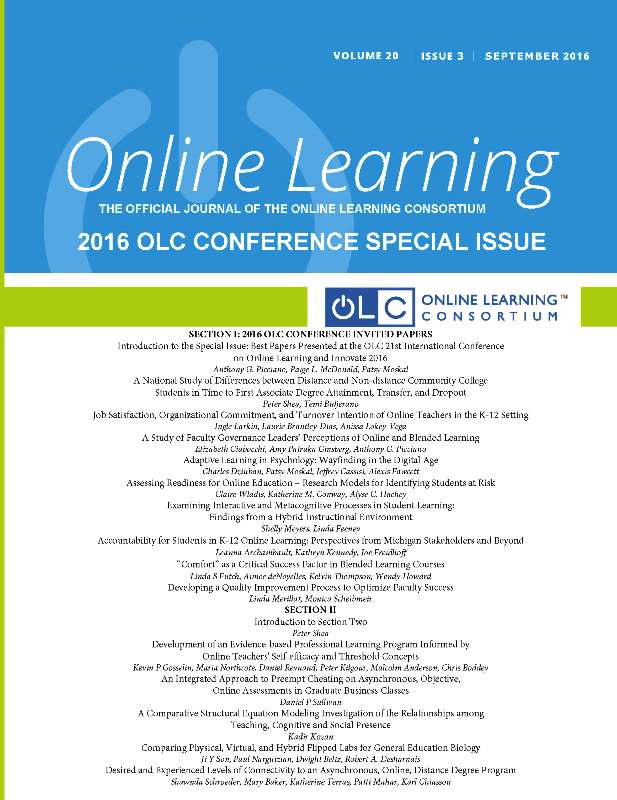Desired and Experienced Levels of Connectivity to an Asynchronous, Online, Distance Degree Program
DOI:
https://doi.org/10.24059/olj.v20i3.691Keywords:
Online learning, student connectivity, connectedness, social presenceAbstract
This study examined graduate students’ desired and experienced levels of connectivity in an online, asynchronous distance degree program. Graduate students enrolled in the Masters of Science in Special Education distance degree program at a Midwest university were surveyed on both desired and experienced connectivity to their program, students, instructors, and advisors. Overall, student’s desired and experienced high connectivity to the program, their advisors, and their instructors; experiencing and wanting less connectivity to their fellow students. Specifically, three significant findings were noted: (1) students wanted high connectivity overall, with greatest connectivity desired with advisors and less connectivity wanted with other students; (2) there was variation among age cohorts and wanted connectivity with peers, advisors, instructors, and the program with statistically significant differences with regard to instructors, and other students; and (3) students experienced high connectivity. The relationships between graduate online learners and their instructors and advisors were correlated with the level of connectivity students experienced with their program. It was not as important to foster high connectivity among peers in the online learning environment. Further study should compare desired and wanted connectivity between departments, and across other universities to determine variables that may influence connectivity, and to identify best practices.References
Allen, I. E., & Seaman, J. (2013). Changing course: Ten years of tracking online education in the United States. Babson Park, MA:
Babson Survey Research Group and Quahog Research Group, LLC.
Aragon, S. R. (2003). Creating social presence in online environments. New Directions for Adults and Continuing Education 100: 57-68.
Arbaught, J. B. (2001). How instructor immediacy behavior affect student satisfaction and learning in web-based courses. Business Communication Quarterly 64 (4): 42-54.
Corts, D. P., Lounsbury, J. W., Saudargas, J. W., Tatum, R. A., &
Holly, E. (2000). Assessing undergraduate satisfaction with an academic department: A method and case study. College Study Journal 34 (3): 399-408.
Cranton, P. (2001). Becoming an authentic teacher in higher education. Malabar, FL: Krieger.
Crookston, B. B. (1972). A developmental view of advising as teaching. Journal of College Student Personnel 13 (1): 12-17.
Diaz, D. P., & Cartnal, R. B. (1999). Students’ learning styles in two classes: Online distance learning and equivalent on-campus. College Teaching 47 (4): 130-135.
Drouin, M., & Vartanian, L. R. (2010). Students’ feelings of and desire for sense of community in face-to-face and online courses. The Quarterly Review of Distance Education 11 (3): 147-159.
Fabro, K. R., & Garrison, D. R. (1998). Computer conferencing and higher order learning. Indian Journal of Open Learning 7 (1): 41-54.
Gunawardena, C. N. (1995). Social presence theory and implications for interaction and collaboration learning in computer conferences. International Journal of Educational Telecommunications 1: 147-166.
Gunawardena, C. N., & Zittle, F. J. (1997). Social presence as a predictor of satisfaction within a computer-mediated conferencing environment. The American Journal of Distance Education 11 (3): 8-26.
Haythornthwaite, C. (2002). Building social networks via computer networks: Creating and sustaining distributed learning communities. In K. Renninger, and W. Shumar (Eds.). Building virtual communities: Learning and change in cyberspace. Cambridge: Cambridge University Press.
Kehrwald, B. (2008). Understanding social presence in text-based online learning environments. Distance Education 29 (1): 89-106.
Lake, D. (1999). Reducing isolation for distance students: An on-line initiative. Open Learning 14(3): 14.
Reupert, A., Mayberry, D., Patrick, K., & Chittleborough, P. 2009. The importance of being human: Instructors’ personal presence in distance programs. International Journal of Teaching and Learning in Higher Education 21(1): 47-56.
McMillan, D. W., & Chavis, D. M. (1986). Sense of community: A definition and theory. Journal of Community Psychology 14 (1), 6-23.
Mykota, D., & Duncan, R. (2007). Learner characteristics as predictors of online social presence. Canadian Journal of Education 30 (1): 157-170.
Rovai, A. (2002a). Building sense of community at a distance. International Review of Research in Open and Distance Learning 3 (1): 1-16.
Rovai, A. (2002b). A preliminary look at the structural differences of higher education classroom communities in traditional and ALN course. Journal of Asynchronous Learning Networks 6 (1): 41-56.
Rovia, A., & Wighting, M. (2005). Feelings of alienation and community among higher education learners in a virtual classroom. Internet and Higher Education 8: 97-110.
Short, J., William, E., & Christie, B. (1976). The social psychology of communication. New York: John Wiley.
Starr-Glass, D. (2011). Beginning course surveys: Bridge for knowing and bridges for being. The International Review of Research in Open and Distance Learning 31 (5): 537-548.
Swan, K., & Shih, L. F. (2005). On the nature and development of social presence in online course discussion. Journal of Asynchronous Learning Networks 9: 115-136.
Tinto, V. (1993). Leaving college: Rethinking the cause and cures of student attrition (2nd ed.). Chicago, IL: University of Chicago Press.
Woods, R. H., & Baker, J. D. (2004). Interaction and immediacy in online learning. International Review of Research in Open and Distance Learning 5 (2): 1-13.
Zembylas, M., Theodorou, M., & Pavlakis, A. (2008). The role of emotions in the experience of online learning: Challenges and opportunities. Educational Media International 45 (2): 107-117.
Downloads
Published
Issue
Section
License
As a condition of publication, the author agrees to apply the Creative Commons – Attribution International 4.0 (CC-BY) License to OLJ articles. See: https://creativecommons.org/licenses/by/4.0/.
This licence allows anyone to reproduce OLJ articles at no cost and without further permission as long as they attribute the author and the journal. This permission includes printing, sharing and other forms of distribution.
Author(s) hold copyright in their work, and retain publishing rights without restrictions






